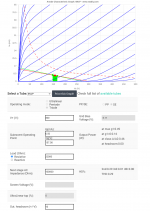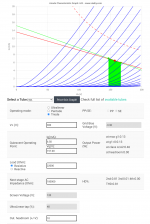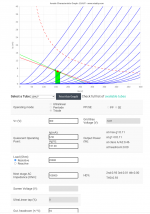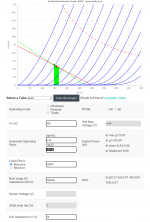They aren't very linear compared to other alternatives. They can make a good follower though.
Personally, I think if the circuit is designed well, almost any tube can sound good - it's more about topology than tube choice IMHO. That's why I'm using 6N14P as buffers in my pre...
Personally, I think if the circuit is designed well, almost any tube can sound good - it's more about topology than tube choice IMHO. That's why I'm using 6N14P as buffers in my pre...
Because they are less linear than many other tube types.
If for instance you compare these datasheets for the ECC40 and the ECC82 you will see that at about the same output voltages the ECC82 is way less linear than the ECC40.
https://frank.pocnet.net/sheets/030/e/ECC40.pdf
https://frank.pocnet.net/sheets/010/e/ECC82.pdf
Addition: The distortion in these small signal triodes is proportional to the output voltage (meaning: half the output voltage will give half the distortion)
If for instance you compare these datasheets for the ECC40 and the ECC82 you will see that at about the same output voltages the ECC82 is way less linear than the ECC40.
https://frank.pocnet.net/sheets/030/e/ECC40.pdf
https://frank.pocnet.net/sheets/010/e/ECC82.pdf
Addition: The distortion in these small signal triodes is proportional to the output voltage (meaning: half the output voltage will give half the distortion)
Last edited:
Yes why,do they sound worse ?
Bad reputation to have a tube that is a classic together with 12AX7? They sound worse compared to what other tube? On what circuit? This is a nonsensical statement. Or the designers at Prima Luna / Mc Intosh and many other manufacturers have not found out yet.
https://www.primaluna-usa.com/preamplifiers
OK, but what about the numbers in the datasheets than? Are they nonsensical too?
The ECC82 has some strong(er) points (like being able to drive good at lower anode voltages). Availability of tube types, their filament consumption, etc. will also be things that professional designers will take into account. But if you are free to go for linearity (like many diy'ers are) you would be far better of choosing the ECC40 than the ECC82.
The ECC82 has some strong(er) points (like being able to drive good at lower anode voltages). Availability of tube types, their filament consumption, etc. will also be things that professional designers will take into account. But if you are free to go for linearity (like many diy'ers are) you would be far better of choosing the ECC40 than the ECC82.
Last edited:
They aren't very linear compared to other alternatives. They can make a good follower though.
Personally, I think if the circuit is designed well, almost any tube can sound good - it's more about topology than tube choice IMHO. That's why I'm using 6N14P as buffers in my pre...
Any tube is linear enough, if the signal is “small”. Even a pentode. If the signal is small enough.
In a follower, the signal (AC voltage between G1 and K) is small even if it is putting out 50 volts peak to peak from K to AC ground. So distortion remains low, even with a 12AU7 or even EL84.
Someone must tell them...This is a nonsensical statement. Or the designers at Prima Luna / Mc Intosh and many other manufacturers have not found out yet.
It is about studying the characteristic curve of a tube and making it work in the section where it behaves best. That depends on the implementation.
Another important aspect to consider is the high availability of the 12AU7 and its affordable costs.
Esoteric brands and / or very good designs (like the one in the attached link) are not available to any fan. I think you have to sell a kidney to access any of them.
So, I would raise the issue backwards. Why are 12AX7 and 12AU7 the favorites of designers?
" Although the Amity is a beautifully simple design, it makes severe demands on the preamp. The preamp has to drive the combined capacitance of the interconnect cable, the input transformer, and the Miller capacitance of the input tubes. This can easily add up to 200 to 600pF of capacitance, depending on how long your cables are and if you choose to use a 1:2 step-up in the input transformer (which quadruples the 60pF Miller capacitance of the input tubes). In all honesty, this is difficult load for most tube preamps, with 12AX7 cathode-follower preamps falling down the worst. (1mA cannot drive 600pF!) Preamps with 12AU7 cathode-followers aren't much better, sounding very "tubey," rolled-off, and old-fashioned."
The Amity, Raven, and Aurora
Another important aspect to consider is the high availability of the 12AU7 and its affordable costs.
Esoteric brands and / or very good designs (like the one in the attached link) are not available to any fan. I think you have to sell a kidney to access any of them.
So, I would raise the issue backwards. Why are 12AX7 and 12AU7 the favorites of designers?
" Although the Amity is a beautifully simple design, it makes severe demands on the preamp. The preamp has to drive the combined capacitance of the interconnect cable, the input transformer, and the Miller capacitance of the input tubes. This can easily add up to 200 to 600pF of capacitance, depending on how long your cables are and if you choose to use a 1:2 step-up in the input transformer (which quadruples the 60pF Miller capacitance of the input tubes). In all honesty, this is difficult load for most tube preamps, with 12AX7 cathode-follower preamps falling down the worst. (1mA cannot drive 600pF!) Preamps with 12AU7 cathode-followers aren't much better, sounding very "tubey," rolled-off, and old-fashioned."
The Amity, Raven, and Aurora
Bad reputation to have a tube that is a classic together with 12AX7? They sound worse compared to what other tube? On what circuit? This is a nonsensical statement. Or the designers at Prima Luna / Mc Intosh and many other manufacturers have not found out yet.
Preamplifiers — PrimaLuna USA
Maybe it's because those tubes are new production and most people who don't know any better know those tube numbers?
The 12A*7 family are all trash IMHO compared to alternatives like 6N*P. Even a triode strapped 6J1P is better (and far less money) than 12AU7...
Just my opinion though, I could be wrong
One can use the 2nd Harmonic distortion from the 12AU7 for cancellation with a later stage, or for some tubey voicing. The tubes -were- cheapo, used in many geetah amps, so still in production.
Although acceptable for follower use, one prefers a higher gm tube for that.
12AT7 takes the 2nd H dist thing further yet, working well in the RH84 to cancel some 2nd H of the EL84 in SE. On the other hand, 12AT7 works well in a diff. stage with low 3rd H and cancelled 2nd H.
Although acceptable for follower use, one prefers a higher gm tube for that.
12AT7 takes the 2nd H dist thing further yet, working well in the RH84 to cancel some 2nd H of the EL84 in SE. On the other hand, 12AT7 works well in a diff. stage with low 3rd H and cancelled 2nd H.
The 12A*7 family are all trash IMHO compared to alternatives like 6N*P. Even a triode strapped 6J1P is better (and far less money) than 12AU7...
And then why didn't they get popular ?
Some plot of the Russians from Svetlana ?
According to this, I'm right (if the OP is identical for each tube rather than being "optimized").
All three plots show 300V B+, 6.5mA idle, 22k load resistor, 100k next stage input.
EDIT: I've added the 6SN7 as most people say it's one of the most linear signal triodes. Indeed it's slightly better than the 6N1P.
Attachments
Last edited:
According to this, I'm right (if the OP is identical for each tube rather than being "optimized").
All three plots show 300V B+, 6.5mA idle, 22k load resistor, 100k next stage input.
That's largely meaningless. There is no reason to believe that any one operating point is best for all tubes in question. It's not a matter of optimization, it's a matter of picking the operating point most suitable for each tube to begin with.
And some tubes may not be suitable at all for a given set of conditions.
OP: Any valid "bad reputation" would be tubes that prove unreliable or don't meet datasheet numbers. That's happened, but it's typically one manufacturer having poor quality, not the tube type in general.
Any hearsay "bad reputation" about a tube type is likely based on improper use/application. Think about it. If the data sheet says 10% distortion at a certain operating point and you get exactly 10%, that may be bad performance for your intended use. But the tube deserves an excellent rating, as it does exactly what it says it will do.
Any hearsay "bad reputation" about a tube type is likely based on improper use/application. Think about it. If the data sheet says 10% distortion at a certain operating point and you get exactly 10%, that may be bad performance for your intended use. But the tube deserves an excellent rating, as it does exactly what it says it will do.
The designer can prevent the outlet tube from working at its maximum gain point, shortening its useful life. He can choose somewhere in between where gain and distortion are compatible with long life and good sound.
It's all a matter of design, I agree that there may be better (and worse) tubes but ask the rock guys what they think of the 12AX7 / 12AU7 duo .......
Accessibility to replacements for them is critical.
When the NAD3020 came out on the market (I am leaving the subject here, it is just to round off the idea) one of the characteristics that was praised, was that the TRs were very easy to get. And weren't there hundreds of designs with the European BC and BD line that were nothing special?
The easy availability of tubes and TR means a lot, there is nothing more frustrating than having an amp on standby because replacements are not available..
It's all a matter of design, I agree that there may be better (and worse) tubes but ask the rock guys what they think of the 12AX7 / 12AU7 duo .......
Accessibility to replacements for them is critical.
When the NAD3020 came out on the market (I am leaving the subject here, it is just to round off the idea) one of the characteristics that was praised, was that the TRs were very easy to get. And weren't there hundreds of designs with the European BC and BD line that were nothing special?
The easy availability of tubes and TR means a lot, there is nothing more frustrating than having an amp on standby because replacements are not available..
That's largely meaningless. There is no reason to believe that any one operating point is best for all tubes in question. It's not a matter of optimization, it's a matter of picking the operating point most suitable for each tube to begin with.
And some tubes may not be suitable at all for a given set of conditions.
Feel free to run more data points and see other OPs to compare. It's typical to have 300V B+ and 6.5mA is typical of the average biasing though, isn't it? Of course there are many other OPs. That's why I bothered to preface it...
Irrespective of operating point it's not hard to see that some types are inherently more linear. This is also true over a very wide range of operating points.
The 12AU7A is not a terrible tube, but there is a lot of variability in ones that were made in North America as compared to European types which IMVLE are generally more linear.
Both the 6CG7 and 6SN7 will better it - even inspecting the curves will tell you that, but there are also much worse tubes.
From experience Mullard, Telefunken, and Philips Miniwatts were pretty good. I think the modern JJ might be OK in this regard as well.
The 12A*7 series were introduced as compact, lower cost replacements for consumer electronics and other applications. They were heavily marketed in the tube era both to the consumer and the design engineer who stuck them in his designs. Cost was an issue as well. Telefunken early on took most of the Hifi OEM market here in the U.S. and they did that by undercutting local producers and also admittedly by making a pretty good product.
The reason we have 12A*7 today probably has more to do with musical instrument amplifiers that needed replacement tubes at a time when very few people were interested in using tubes in new designs. (The 1970s and 1980s) Musicians gigging for a living are often quite price sensitive and will buy cheap foreign off brands in preference to hideously expensive twilight of production types from the remaining stragglers. (Think MPD and the tail end of ECG etc.)
Ubiquity doesn't mean that any particular thing was the best for the purpose, just that it was an economic and serviceable choice for the application. I doubt too many people are hungering for an old chevette or yugo and yet they were common and serviceable for a time.
The 12AU7A is not a terrible tube, but there is a lot of variability in ones that were made in North America as compared to European types which IMVLE are generally more linear.
Both the 6CG7 and 6SN7 will better it - even inspecting the curves will tell you that, but there are also much worse tubes.
From experience Mullard, Telefunken, and Philips Miniwatts were pretty good. I think the modern JJ might be OK in this regard as well.
The 12A*7 series were introduced as compact, lower cost replacements for consumer electronics and other applications. They were heavily marketed in the tube era both to the consumer and the design engineer who stuck them in his designs. Cost was an issue as well. Telefunken early on took most of the Hifi OEM market here in the U.S. and they did that by undercutting local producers and also admittedly by making a pretty good product.
The reason we have 12A*7 today probably has more to do with musical instrument amplifiers that needed replacement tubes at a time when very few people were interested in using tubes in new designs. (The 1970s and 1980s) Musicians gigging for a living are often quite price sensitive and will buy cheap foreign off brands in preference to hideously expensive twilight of production types from the remaining stragglers. (Think MPD and the tail end of ECG etc.)
Ubiquity doesn't mean that any particular thing was the best for the purpose, just that it was an economic and serviceable choice for the application. I doubt too many people are hungering for an old chevette or yugo and yet they were common and serviceable for a time.
At one of the early VSACs in Silverdale Washington (perhaps 1997), there was a preamp tube shootout.
The various tubes were used in a line preamp.
The audience was not told the plate voltage, bias voltage, plate current, or plate load.
Of course some of those values changed, because the circuit values such as B+, RL, were not changed. I do not remember if the tubes were self biased, or fixed biased.
But whichever bias was used, it was not changed (fixed bias voltage, or self bias resistor).
But with those fixed values, it is sure that the plate current, and plate voltage would be different for different tube types.
It was an exercise of plug and play, listen, listen, listen . . . with no changes to the circuitry.
Ahhh, there possibly may have been a bias adjustment to keep all plate currents the same, and that would have meant all plates were at the same voltage.
To the surprise of all, the 12AU7 won the most 'best sound votes' of several different types of tubes.
Just saying.
P.S. For those of you who did not go to any VSAC, those were Vacuum tube State of the Art Conferences. Lots of fun, educational, with seminars, listening rooms; live music; a room for hobbyists to have their preamps, amplifiers, speakers, etc. shown and heard; and lots of experts in the field.
Never to be repeated, the last one was in Vancouver, Washington, 2008.
Thanks to all who participated in any way.
Rest in Peace VSAC.
The various tubes were used in a line preamp.
The audience was not told the plate voltage, bias voltage, plate current, or plate load.
Of course some of those values changed, because the circuit values such as B+, RL, were not changed. I do not remember if the tubes were self biased, or fixed biased.
But whichever bias was used, it was not changed (fixed bias voltage, or self bias resistor).
But with those fixed values, it is sure that the plate current, and plate voltage would be different for different tube types.
It was an exercise of plug and play, listen, listen, listen . . . with no changes to the circuitry.
Ahhh, there possibly may have been a bias adjustment to keep all plate currents the same, and that would have meant all plates were at the same voltage.
To the surprise of all, the 12AU7 won the most 'best sound votes' of several different types of tubes.
Just saying.
P.S. For those of you who did not go to any VSAC, those were Vacuum tube State of the Art Conferences. Lots of fun, educational, with seminars, listening rooms; live music; a room for hobbyists to have their preamps, amplifiers, speakers, etc. shown and heard; and lots of experts in the field.
Never to be repeated, the last one was in Vancouver, Washington, 2008.
Thanks to all who participated in any way.
Rest in Peace VSAC.
Last edited:
- Home
- Amplifiers
- Tubes / Valves
- Why do ECC82/12AU7 have a bad reputation in hifi?



